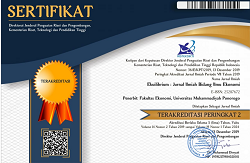Optimum Government Size and Economic Growth in Indonesia: ARDL Model Approach
DOI: 10.24269/ekuilibrium.v18i1.2023.pp37-47
Abstract
This study aims to determine the optimal government spending by analyzing the long-term and short-term relationship between government size and economic growth in Indonesia. The method used in this study is the ARDL model with secondary data from the World Development Indicators in 1966-2021. The results of the analysis show that initially government size has a significant positive effect on economic growth in the short run. But, in the long term, when the government size variable is in the form of a quadratic to determine a non-linear relationship, it shows a negative relationship to economic growth with a safe limit expenditure of 57.9% of national income. This study is in accordance with the Armey curve hypothesis. The policy recommendation in this study proposes that the government needs to control the amount of the budget so that its expenditure does not exceed the threshold.
Keywords
Optimum Government Size, Economic Growth, ARDL Model
References
- Abdillah, K., Handoyo, R. D., & Wasiaturrahma, W. (2020). The Effect of Control Corruption, Political Stability, Macroeconomic Variables on Asian Economic Growth. Ekuilibrium: Jurnal Ilmiah Bidang Ilmu Ekonomi, 15(2), 161-169.
- Akram, V., & Rath, B. N. (2020). Optimum government size and economic growth in case of Indian states: Evidence from panel threshold model. Economic Modelling, 88, 151-162.
- Altunc, O. F., & Aydın, C. (2013). The relationship between optimal size of government and economic growth: Empirical evidence from Turkey, Romania and Bulgaria. Procedia-Social and Behavioral Sciences, 92, 66-75.
- Armey, R. K., & Armey, D. (1995). The freedom revolution: the new republican house majority leader tells why big government failed, why freedom works, and how we will rebuild America: Regnery Pub.
- Asimakopoulos, S., & Karavias, Y. (2016). The impact of government size on economic growth: A threshold analysis. Economics Letters, 139, 65-68.
- Bank, W. (2022). World development indicators 1966-2020: The World Bank.
- Bozma, G., Başar, S., & Murat, E. (2019). Investigating validation of Armey curve hypothesis for G7 countries using ARDL model. Doğuş Üniversitesi Dergisi, 20(1), 49-59.
- Can, C. K., & Aktaş, E. E. (2022). Quantifying the optimal long-run level of government expenditures in Turkey: 1968-2019. Ekonomski Vjesnik, 35(1), 69-86.
- Chen, J. (2020). Research on the relationship between government size and economic growth. Modern Economy, 11(2), 209-219.
- Chen, S.-T., & Lee, C.-C. (2005). Government size and economic growth in Taiwan: A threshold regression approach. Journal of Policy Modeling, 27(9), 1051-1066.
- Chobanov, D., & Mladenova, A. (2009). What is the optimum size of government. Institute for Market Economics, Bulgaria, 1-47.
- DiPeitro, W. R., & Anoruo, E. (2012). Government size, public debt and real economic growth: a panel analysis. Journal of Economic Studies.
- Facchini, F., & Melki, M. (2011). Optimal government size and economic growth in France (1871-2008): An explanation by the State and market failures.
- Friedman, M. (1997). If only the US were as free as Hong Kong. Wall Street Journal, 9(6), 20-32.
- Hajamini, M., & Falahi, M. A. (2018). Economic growth and government size in developed European countries: A panel threshold approach. Economic Analysis and Policy, 58, 1-13.
- Herath, S. (2012). Size of government and economic growth: A nonlinear analysis. Economic annals, 57(194), 7-30.
- Keho, Y. (2017). The impact of trade openness on economic growth: The case of Cote d’Ivoire. Cogent Economics & Finance, 5(1), 1332820.
- Koskei, N. S. I., Buigut, K., & Kibet, J. (2013). Impact of openness, foreign direct investment, gross capital formation on economic growth in Kenya. Journal of Economics and Sustainable Development, 4(14), 130-135.
- Lahirushan, K., & Gunasekara, W. (2015). The impact of government expenditure on economic growth: A study of Asian countries. International Journal of Humanities and Social Sciences, 9(9), 3152-3160.
- Makin, A. J., Pearce, J., & Ratnasiri, S. (2019). The optimal size of government in Australia. Economic Analysis and Policy, 62, 27-36.
- Malefane, M. R., & Odhiambo, N. M. (2021). Trade openness and economic growth: empirical evidence from Lesotho. Global Business Review, 22(5), 1103-1119.
- Manasseh, C. O., Abada, F. C., Okiche, E. L., Okanya, O., Nwakoby, I. C., Offu, P., Nwonye, N. G. (2022). External debt and economic growth in Sub-Saharan Africa: Does governance matter? Plos one, 17(3), e0264082.
- Maulid, L. C., Bawono, I. R., & Sudibyo, Y. A. (2021). The Effect of Government Expenditure on Economic Growth in Indonesia. Ekuilibrium: Jurnal Ilmiah Bidang Ilmu Ekonomi, 16(1), 24-38.
- Miller, J. C. (2018). Using the Armey Curve to measure the size of government. Economic Analyst.
- Mose, N., Kibet, L., & Kiprop, S. (2020). An Analysis of Optimal Government Size for Growth: Application of Scully Model in Kenyan Counties. Kabarak Journal of Research & Innovation, 9(1).
- Murshed, M., Mredula, F., & Tabassum, F. (2018). An empirical assessment of optimal government size and economic growth in light of the Armey Curve: a panel data investigation. World Review of Business Research, 8(1), 161-173.
- Mwakalila, E. (2019). Foreign aid, External Debt and Economic Growth in Africa: it all depends on Governance. African Journal of Governance and Development, 8(2), 7-23.
- Nirola, N., & Sahu, S. (2019). The interactive impact of government size and quality of institutions on economic growth-evidence from the states of India. Heliyon, 5(3), e01352.
- Olaleye, S. O., Edun, F., Bello, H. T., & Taiwo, S. B. (2014). Government expenditure and economic growth: An empirical analysis of the Armey Curve in Nigeria. Romanian Economic Journal, 17(51), 47-66.
- Onyibor, K., Bah, S. İ., & Tomiwa, A. (2018). Aid-growth relationship: evidence from a co-integratıon analysis for the five poorest countries of the world. LAÜ Sosyal Bilimler Dergisi, 9(2), 121-137.
- Pesaran, M. H., Shin, Y., & Smith, R. J. (2001). Bounds testing approaches to the analysis of level relationships. Journal of applied econometrics, 16(3), 289-326.
- Santika, A. R., & Qibthiyyah, R. M. (2020). Government Size dan Pertumbuhan Ekonomi di Indonesia. Jurnal Ekonomi dan Pembangunan Indonesia, 20(2), 212-230.
- Sun, P., & Heshmati, A. (2010). International trade and its effects on economic growth in China.
- Vasilev, A. (2020). The Armey Curve in Bulgaria (2000-18)–Theoretical Considerations and Empirical Results. Theoretical and Practical Research in Economic Fields, 11(1 (21)), 19-24.
- Vedder, R. K., & Gallaway, L. E. (1998). Government size and economic growth: The Committee.
- Winanto, A. R. (2019). Investment, Labor and Their Effects on Economic Growth of Ponorogo Regency. Ekuilibrium: Jurnal Ilmiah Bidang Ilmu Ekonomi, 14(1), 68-83.
Refbacks
- There are currently no refbacks.

This work is licensed under a Creative Commons Attribution-ShareAlike 4.0 International License.













